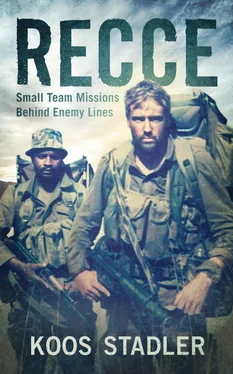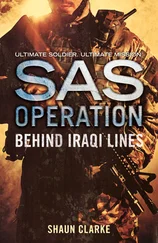I wasn’t a pretty sight when I quietly slipped into Zelda’s folks’ home in the early hours of the morning, but everyone was asleep and I got to bed without anyone noticing. But eventually I had to get up and show my badly swollen face. I had barely slept due to the pain and discomfort. I looked decidedly rotten as I walked into the kitchen, where Zelda, her folks and her brother were having their Sunday-morning breakfast.
Zelda’s mom immediately assumed that I had been involved in a bar brawl – “so typical of the Recces”. There was no way of explaining this one away, having disappeared from their home on a Saturday and returned at some ungodly hour with a face apparently smashed to a pulp. To this day they believe I told them a tall tale. It took much explaining just to convince Zelda, but eventually she accepted Vic’s version, as she adored and trusted him. She gave me a hard time for causing damage to my pretty little face.
We now moved to a phase of detailed planning for the deployment, spending many hours on the execution of the deployment, and on routes towards the target areas and the actual points on the line we wanted to attack. As usual, we meticulously worked out and rehearsed emergency procedures for every possible contingency. At the Joint Aerial Reconnaissance and Intelligence Centre (JARIC) at Waterkloof Air Force Base, bent over maps and aerial photos of southwestern Angola, we worked out the details of every leg, emergency RVs and escape routes.
JARIC had state-of-the-art facilities, and for the first time I had the amazing experience of “riding” the stereoscopes. Enlarged stereo pairs of photos covering the target area were laid out under a massive stereoscope. The operator would get into a seat and steer the scope across the photo sets, which would allow him to fly virtually over a landscape that would “jump” out at him in 3D. The experience was so realistic that I became nauseous after a few minutes’ “flying” in the machine.
Then the day arrived on which I, as the mission commander, had to do the in-house ops briefing for the deployment. While I was mentally and physically exceptionally well prepared for the mission, presenting our plan seemed like an insurmountable hurdle. I couldn’t imagine selling my story convincingly to General Joep Joubert, then GOC Special Forces, and all his staff officers. In those days the mission commander would normally do the “in-house” ops briefing to the GOC, followed by a briefing to the Chief of the Defence Force the next day, given that the mission had been approved at Special Forces level.
In attendance at the in-house briefing would be all the staff officers involved with the operation as well as representatives from other departments and arms of service. The Air Force would be represented by the air liaison officer (ALO) dedicated to the deployment, while the medics would be represented by the OC 7 Medical Battalion. The plan would only be approved if all these elements were able to provide support.
As it turned out, my first briefing as mission commander to the GOC Special Forces proved to be more challenging than crawling into enemy-infested targets in hostile countries.
Commandant (the rank was later changed to lieutenant colonel) Ormonde Power, the Ops officer dedicated from Special Forces HQ to the operation, started with the introductions and presented the mission, and then Dave Drew covered the intelligence picture. By the time he introduced me I was almost paralysed by nerves. From the start my transparencies got mixed up, which caused me to start fumbling around with my notes, and I lost my thread. Eventually General Joubert stopped me.
“Stadler,” he said, “what’s this circus? You want to do this operation or not?”
I was nearly in a state of panic. All our hard work, the long hours of preparation and nights of rehearsals were at stake.
“Yes, General, we want to do it, and we are very well prepared,” I managed to blurt out.
“Forget your bloody notes; tell me the story,” he exclaimed.
Then, probably to help me save some face, he started asking me questions about the deployment.
“I want to hear your mission again.”
I ran through it without even glancing at the pinned-up mission statement.
“Now, tell me what it is you really want to do.”
General Joubert was addressing me like the mildly impatient father of a son who had arrived home from school with poor marks.
“Okay, now take me through your execution, step by step…”
This I could do well, since the map of our deployment was ingrained in my mind, and I had every single detail of the mission at the tips of my fingers. I took the general through every phase, explaining the details of the infiltration, execution and exfiltration on the map in front of them. Knowing that the Air Force would take issue with it, I explained the emergency procedures in the finest detail – our escape and evasion (E&E) route, emergency RVs, when and where we would like the telstar (comms relay aircraft) to fly if communications were lost, identification procedures and emergency extraction requirements.
At the end of the briefing General Joubert half-turned in his chair and, in typical fashion, stared at the staff, and then asked: “Any issues, anyone? Can you support the trooper?” I didn’t even blink at the sudden demotion. I knew I had stuffed up badly. But, aside from a few technical clarifications, there were no further issues and the plan was approved.
That, however, was not the end of my woes. Sitting quietly next to General Joubert throughout the presentation was the fierce and, I must add, much-feared Brigadier Chris “Swarthand” (Black Hand) Serfontein, then the second-in-command of Special Forces. As I packed up my aids, Swarthand walked up to me, gripped me firmly by the wrist and ushered me out of the ops room to his office.
“Where do you come from? Have you never learned to do presentations? Haven’t you done Formative?” he asked, referring to the leadership and management course all young Permanent Force officers had to complete. Now I expected the worst.
I started mumbling, but the brigadier forced me to sit down at the conference table in his office, and then walked around and sat opposite me.
“Do you realise that, now that the operation has been approved, you are presenting to the Chief tomorrow?”
Swarthand was spitting fire, his eyes boring into mine.
“Ja, Brigadier.”
“Are you going to stuff up as badly tomorrow as you did today?”
“No, Brigadier.”
“Now listen carefully…” he said pointedly. “Go and fetch your aids and bring it here. Let me show you a few tricks.”
To my surprise, Swarthand Serfontein then took the rest of that day to show me how to do an ops briefing, explaining the nuances of effective communication, style and language. He forced me to repeat every single part of the briefing over and over again, there in the privacy of his office, and patiently corrected me whenever he thought I could do better.
Late that night, at the Karos Hotel, I got a phone call from Dave Drew. “Koos, I hate to tell you this, but the general does not want you to present tomorrow,” he said. “I am to do the Int and the Ops briefing – on your behalf.”
I was furious, but what could I say? Dave was obviously just conveying the message from the general. I left it at that and went to bed, thinking hard about how I would handle the situation.
The next morning I phoned Serfontein. “Brigadier,” I said, “this is my operation. If anyone is to present it to the Chief, it’s me …”
And that was it. Swarthand Serfontein didn’t hesitate. “You go ahead; I’ll mention it to the boss. Just do your best,” he said and put the phone down. Just like that, no questions asked.
Читать дальше












